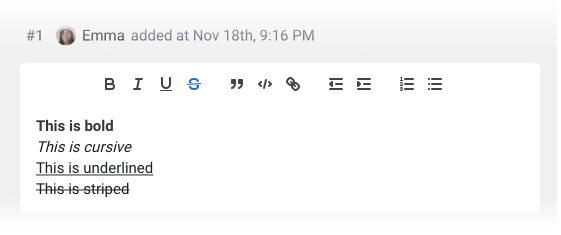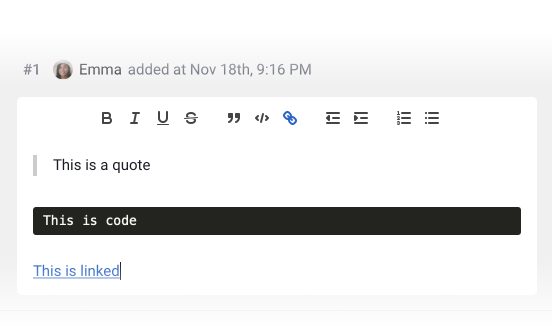There are a variety of features in notes to structure, personalize and highlight information.
In this guide, we'll go over the different text editing features you can use to format and improve your notes in Rock.
Every written note can contain up to 10.000 characters. If you want to write more you can always create several notes or attach a Google Doc to your space.
Main text features
There are four main text editing features: bolden, cursive, and strikethrough. Besides using the dedicated button in the note you can also enable a few of these features through the use of keyboard shortcuts:
- Bold: Hover over and select the text you want to bold, then press control + B on Windows or Command ⌘ + B on Mac to bold text.
- Italic: Hover over and select the text your want to change to italic, then press control + I on Windows or Command ⌘ + I on Mac to set text to italic.
- Strikethrough: You can currently only stripe through text by pressing the "S" icon next to the underline.

There is currently a bug affecting our underline formatting option. Underlining a text won’t show as underlined even though it’s been saved. We’re aware and we’re looking to work on it.
Advanced text features
- Quotes: Add quotes from people or things mentioned in a meeting to reference a person specifically. Press the quote icon to activate it.
- Code: Write relevant code in your notes and inverse the view of the information to a black background with white text. Select </> to activate the feature.
- Embed Links: Embed links by selecting text and pressing the link icon 🔗. When manually writing a URL (beginning with www) it will also be clickable.

Text position and lists
- Decrease indent: Move text forward by one tab position.
- Increase indent: Move text back by one tab position.
- Bulleted list: Start a bullet list, like this very one you are currently reading.
- Numbered lists: Start a numbered list: 1,2,3 and so on...
You can also use indentation with bulleted and numbered lists to build out multilevel lists in order to better detail ideas and sub-ideas within your notes.

Mention anywhere and other features
It’s possible to mention tasks, topics, spaces, attachments, and other notes in a note’s body. This is important especially when you’re trying to cross-reference other materials into the notes.
You can’t mention users in the body of the note but you can mention users in the comments section.Aside from mentions, you can also upload or link attachments to notes which are connected files with relevant information to the note, think of any type of files such as images (JPEG, PNG...), video files, or PDF documents.
Note that a note must have text in order to save it, so if you want to only add attachments you would still have to add text.You can also add labels to note if you wish to further categorize them. Additionally, you can add yourself or other users as followers if you want to receive notifications for comments in the note even when not directly mentioned.
Frequently Asked Questions on Formatting?
Who can use formatting in notes?
At the moment, only users who are in spaces with the member or admin roles can edit notes. Guests can still contribute by leaving comments but edits can only be made by members or admins.
What happens if the note goes beyond 10,240 characters?
Users won't be able to input anything in the note once it reaches 10,240 characters. If you need to write down notes that are longer than 10,240 characters, you can write another note or attach a file to it.
Why is formatting important?
Formatting in notes helps improve the readability and clarity of the text. It will make it easier for everyone in the space to understand or skim through the notes.
Can I use emojis in my notes?
Yes! Emojis are supported in both the note title/name and body/contents. You can put as many emojis as you want as long as it’s within the 10,240 character limit.
How many files/cloud files can I attach to a note?
You can attach up to 100 files on a note. It’s a combined limit of both cloud files and local attachments.
Will people automatically have access to the attached cloud files in my notes?
No. Permission needs to be granted from their cloud service provider (Google, Microsoft, Dropbox, etc.) before people can view the files from their Rock app.
Up to how many levels can you create on lists?
The indent format function allows you to create multilevel lists (both numbered and bulleted) in order to improve note details and enumeration. However, you can only create up to 9 levels. After that, the editor will not allow you to indent further.













